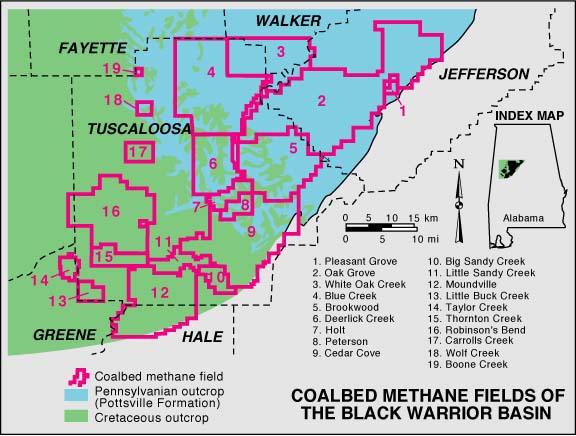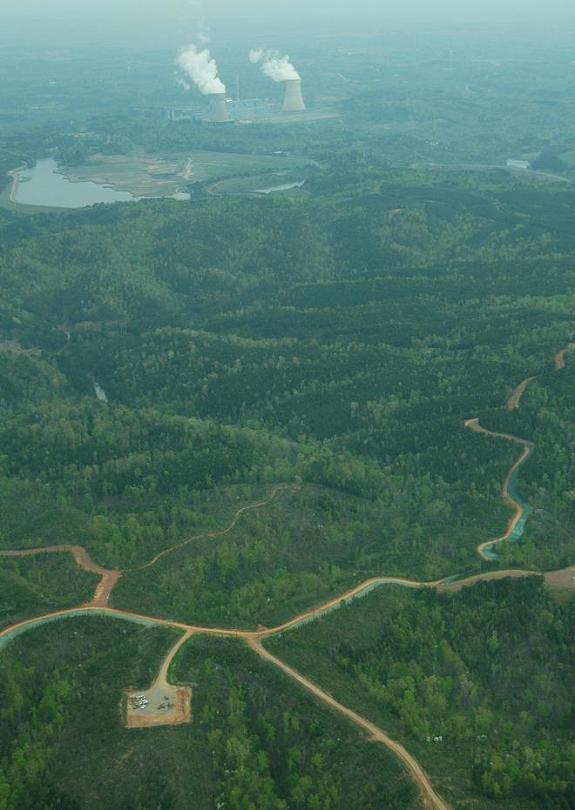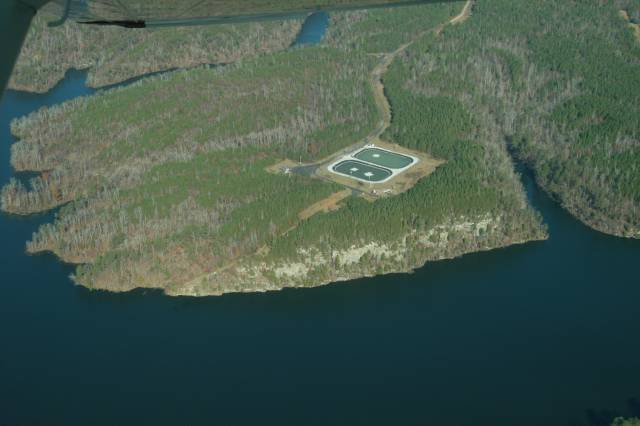The first drilling for coalbed methane – aka natural gas – in Alabama occurred in the Black Warrior Basin in the 1970s. Initially, this practice served as a way to degasify coal seams prior to mining them, to attempt reducing the potential for explosions in mines. The gas was simply vented into the atmosphere. In the early 1980s, when it was realized natural gas has tremendous energy potential, drilling for commercial sales really took off. The Black Warrior Basin has the longest development history of any coalbed methane reserve in the United States.
There were 5,537 coalbed methane (CBM) wells operating in the Black Warrior River watershed (as of April 2012).
Tens of thousands of acres in the Black Warrior Basin are leased for drilling wells to access coal seams where the gas is trapped, creating a massive network of roads, well pads, and pipelines. Erosion from these areas is a documented source of sedimentation, choking streams and reservoirs throughout the basin.
The extraction of coalbed methane involves a process known as hydraulic fracturing (aka “fracking”). Hydraulic fracturing forces a pressurized fluid mixture including water, acid, surfactant, gel, chemicals, and sand into the earth around coal seams, ranging anywhere from 350 – 2,500 feet deep. The fluids create underground fissures in targeted coal seams and surrounding rock and shale, and phenolic resin-coated sand holds the fissures open, allowing natural gas to flow toward the surface.
In the Black Warrior Basin, coalbed methane drilling targets the Pennsylvanian Pottsville Formation, which is part of an unconfined aquifer, and the Cretaceous outcrop, which is associated with high groundwater salinity.
Groundwater contamination is a major concern for people living in rural areas near CBM drilling operations. We have received numerous reports from people whose well water has gone bad. If you have experienced a decrease in well water quality, please contact us. (205) 458-0095
Wastewater from the drilling process, called produced water, is commonly stored in open, lined pits. Some of this water is re-used. The state of Alabama allows CBM operators to discharge produced water to both area streams and the river as well as to wastewater treatment plants.
Map of National Pollutant Discharge Elimination System permitted CBM wastewater discharges in the Black Warrior basin:
Coalbed methane, or natural gas, is a fossil fuel which has significant full-cycle costs as a form of energy – from drilling using hydraulic fracturing, waste and wastewater disposal, methane leakage, pipeline transport, and consumption at power plants and homes.
To see an Alabama Oil & Gas Board map of CBM operations’ footprint in the Warrior Coal Field, click here.
 Map showing coalbed methane fields in the Black Warrior River watershed. Source: Geological Survey of Alabama’s website:
Map showing coalbed methane fields in the Black Warrior River watershed. Source: Geological Survey of Alabama’s website:
http://www.gsa.state.al.us
 Coalbed methane well and roads in the foreground. Miller Steam Plant in the background. (Jefferson Co., AL) Photo by Nelson Brooke.
Coalbed methane well and roads in the foreground. Miller Steam Plant in the background. (Jefferson Co., AL) Photo by Nelson Brooke.
 Coalbed methane wastewater ponds on the Black Warrior River. (Tuscaloosa Co., AL) Photo by Nelson Brooke. Flight provided by SouthWings.org
Coalbed methane wastewater ponds on the Black Warrior River. (Tuscaloosa Co., AL) Photo by Nelson Brooke. Flight provided by SouthWings.org
For more information on this subject, click on any of the following links:
Organizations working on natural gas fracking
EarthWorks – Hydraulic Fracturing 101
EarthWorks – Oil & Gas Accountability Project
Wilderness Society – Hydraulic Fracturing: An Unregulated Danger to Our Nation’s Drinking Water
ProPublica – Fracking: Gas Drilling’s Environmental Threat
ProPublica – From Gung-Ho to Uh-Oh: Charting the Government’s Moves on Fracking
Halliburton Watch – Energy Bill
Union of Concerned Scientists – EPA Findings on Hydraulic Fracturing Deemed “Unsupportable”
Agencies
Alabama Oil & Gas Board – Oil & Gas Information
Geological Survey of Alabama – Coal Systems
Geological Survey of Alabama – Coalbed Methane Research
EPA – Coalbed Methane Extraction (CBM)
EPA – Coalbed Methane Outreach Program (CMOP)
EPA – Hydraulic Fracturing Research Study
EPA – U.S. Methane Emissions 1990 – 2020: Inventories, Projections, and Opportunities for Reductions
National Energy Technology Laboratory – Natural Gas Resources
National Energy Technology Laboratory – Produced Water Management Information System
Southeast Regional Carbon Sequestration Partnership (SECARB) – Black Warrior Basin Coal Seam Project
Industry
Coalbed Methane Association of Alabama
Kinder Morgan (acquired El Paso Production Company on 5/24/12) – Southern Natural Gas
Halliburton Energy Services – 6/9/10/ Comments to EPA on Hydraulic Fracturing
Articles
N.Y. Assembly Approves Fracking Moratorium
Insiders Sound an Alarm Amid a Natural Gas Rush
A Pot of Gold – or a Fracking Disaster Waiting to Happen?
Could Shale Gas Power the World?
Major fracking spill happening now in Pennsylvania
As Focus On Fracking Sharpens, Fuel Worries Grow
The Real Story About the Risks of Fracking
There is a middle ground in gas well fracturing controversy
EPA sounds alarm on fracking in Wyoming
EPA: Fracking chemicals likely tainted Wyoming drinking water
The Fracking Industry’s War On The New York Times – And The Truth












